Part 2: Organisation and Management of Benefit Administration
The Ministry of Social Development
2.1
The Ministry is a combination of two previous organisations – the Department of Work and Income (otherwise known as Work and Income New Zealand or WINZ) and the Ministry of Social Policy.
2.2
WINZ was originally created in 1998 through a merger of the Employment Service division of the Department of Labour and the Income Support business unit of the Department of Social Welfare. WINZ was given the task of helping beneficiaries to achieve stable employment and self-sufficiency, as well as administering benefit payments. The Ministry has now taken over both of these roles.
2.3
Processing benefit applications and payments is an important part of the Ministry’s role and forms the majority of work conducted at its service centres. However, the Purchase Agreement between the Minister of Social Services and Employment and the Chief Executive of the Ministry puts greater emphasis on work placement – reflecting a priority on placing beneficiaries into stable and sustainable employment. The current Key Performance Indicators (KPIs) for service delivery include two relating to the processing of benefits – one for accuracy and one for timeliness – compared with a larger number of KPIs that are directed at work placement.
Geographic Structure
2.4
Figure 2 on the next page illustrates the manner in which the Ministry’s offices are structured throughout the country.
Figure 2
The Ministry’s Geographic Structure
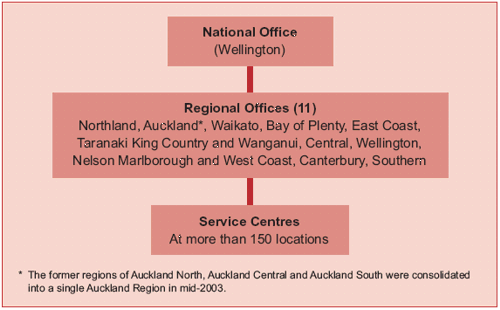
Service Centre Staffing
2.5
Within each service centre, the essential levels of operational staff are:
- Service Centre Manager – who leads the service centre team, and is responsible for the quality of service delivery and the achievement of business plan objectives.
- Team Coaches – who provide coaching, feedback, tuition and support to case managers to enable them to grow in their role and achieve a high level of service and excellent outcomes for their clients.
- Case Managers – who manage a caseload of clients, providing ongoing case management services to individual Work and Income clients within their caseload.
Functional Structure
2.6
The Ministry is organised into two key operational areas (see Figure 3 on the opposite page):
- Service Delivery (Work and Income) is done by case managers who, in respect of administering benefit payments, are primarily responsible for ensuring that what the Ministry pays a beneficiary is accurate from the outset. Case managers are responsible for assisting beneficiaries to achieve stable employment.
- Specialist Services provides a range of services to discrete population groups – Studylink, the Community Services Card, International Services, War Pension Services, Benefit Control (including the National Data Match Centre) and Debt. Area Benefit Control teams have responsibility for detecting over-payments resulting from fraud. They also have intervention strategies to ensure that the client is in receipt the correct benefit. The National Data Match Centre matches information with other government agencies and establishes overpayments, where it is clear the client was not entitled to a benefit or should have been on a lower rate of benefit.
Figure 3
The Ministry’s Functional Structure
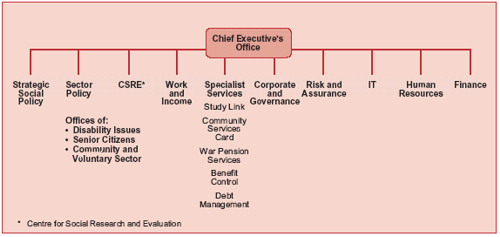
Types of Benefit
2.7
Benefit types are structured in three tiers (see Figure 4 on the next page):
- First-tier benefits comprise the core entitlement based on the beneficiary’s reason for the benefit application – for example, Domestic Purposes Benefit, Unemployment Benefit, Sickness Benefit, and Invalids Benefit.
- Second-tier benefits – known as “Supplementary Benefits” – are an entitlement where the beneficiary has a particular set of circumstances that incur extra costs. These benefits include the Accommodation Supplement, Disability Allowance and Child Disability Allowance.
- Third-tier benefits provide assistance for people who have a (generally) temporary need, and are an acknowledgement that the core and supplementary benefits will not always enable the beneficiary to meet costs that result from an emergency or unexpected situation. Payment of a third-tier benefit is discretionary and is not an entitlement until such time as a decision to exercise the discretion has been taken. Third-tier benefits include recoverable and non-recoverable Special Needs Grant, Advances, and Special Benefit.
Figure 4
The Three Tiers of Benefit
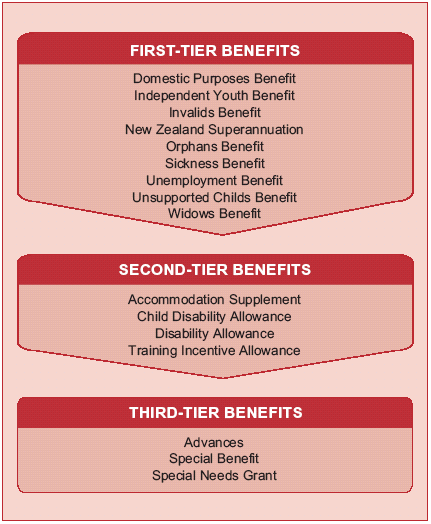
Figure 5
Components of the Benefit System
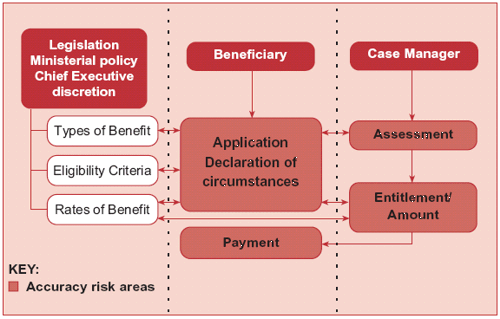
The Benefit System
2.8
The provisions of the Social Security Act 1964 broadly dictate the way in which the benefit system works. Benefit types, eligibility criteria, and rates are set by (one or more of) legislation, Ministerial policy, and the exercise of discretion by the Ministry’s Chief Executive.
2.9
Under section 12(1) of the Social Security Act, the Ministry can grant benefits only to people who make a “claim” for a benefit. However, when making application, the claimant is not required to specify a particular monetary benefit to be eligible for it.6
2.10
The Ministry is not legally obliged to seek out people who may be eligible for a benefit but have not applied. However, every person eligible to receive a benefit and who applies for it should expect to be paid the amount they are entitled to receive. After receipt of the application, the Ministry’s Chief Executive has a legal duty to “investigate”7 the claim to a benefit. It is only after this investigation that an “entitlement” to a benefit is established.
2.11
Consequently, application, assessment and entitlement comprise the key components of the benefit system – as illustrated in Figure 5 on the previous page, which indicates the key areas where risks to accuracy arise.
The Work of a Case Manager
2.12
Case managers make most of the decisions on payments. The main responsibility for ensuring that payments are accurate therefore lies with case managers.
2.13
Figure 6 on the opposite page illustrates eight key Service Delivery activities and their various components that can have an effect on the work of the case manager. For example, case manager training is carried out at three levels:
- the service centre – involving the case manager and their team coach;
- regional level – where the regional trainer and regional operations manager plan the training of service centre staff in their region; and
- national level – which deals with induction training and training in new initiatives.
Figure 6
Activities That Can Affect Case Manager Accuracy
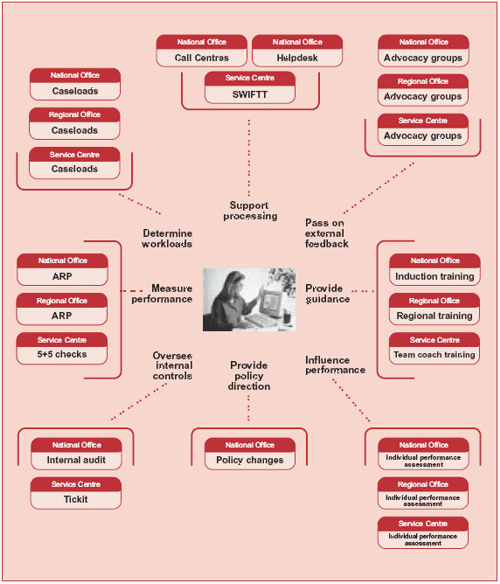
Which of These Activities Have the Greatest Effect on Accuracy?
2.14
In our view, some of these activities, if altered, would have a noticeable effect on levels of accuracy. Others, while important, would have a less direct effect.
2.15
We concluded from our own observations and discussions with the Ministry’s staff that the following four activities potentially have the greatest effect on case manager accuracy:
- case managers’ caseloads;
- checks on case managers’ performance (the 5+5 checks);
- team coaches’ support and training of case managers; and
- case manager performance assessments.
2.16
We explore some of the potential implications for accuracy of each of the four activities in Part Four on pages 41-53.
6: Chief Executive of the Department of Work and Income v Scoble [2001] NZAR 1011.
7: The Ministry prefers to use the term “assess”. We use that term in our report.
page top